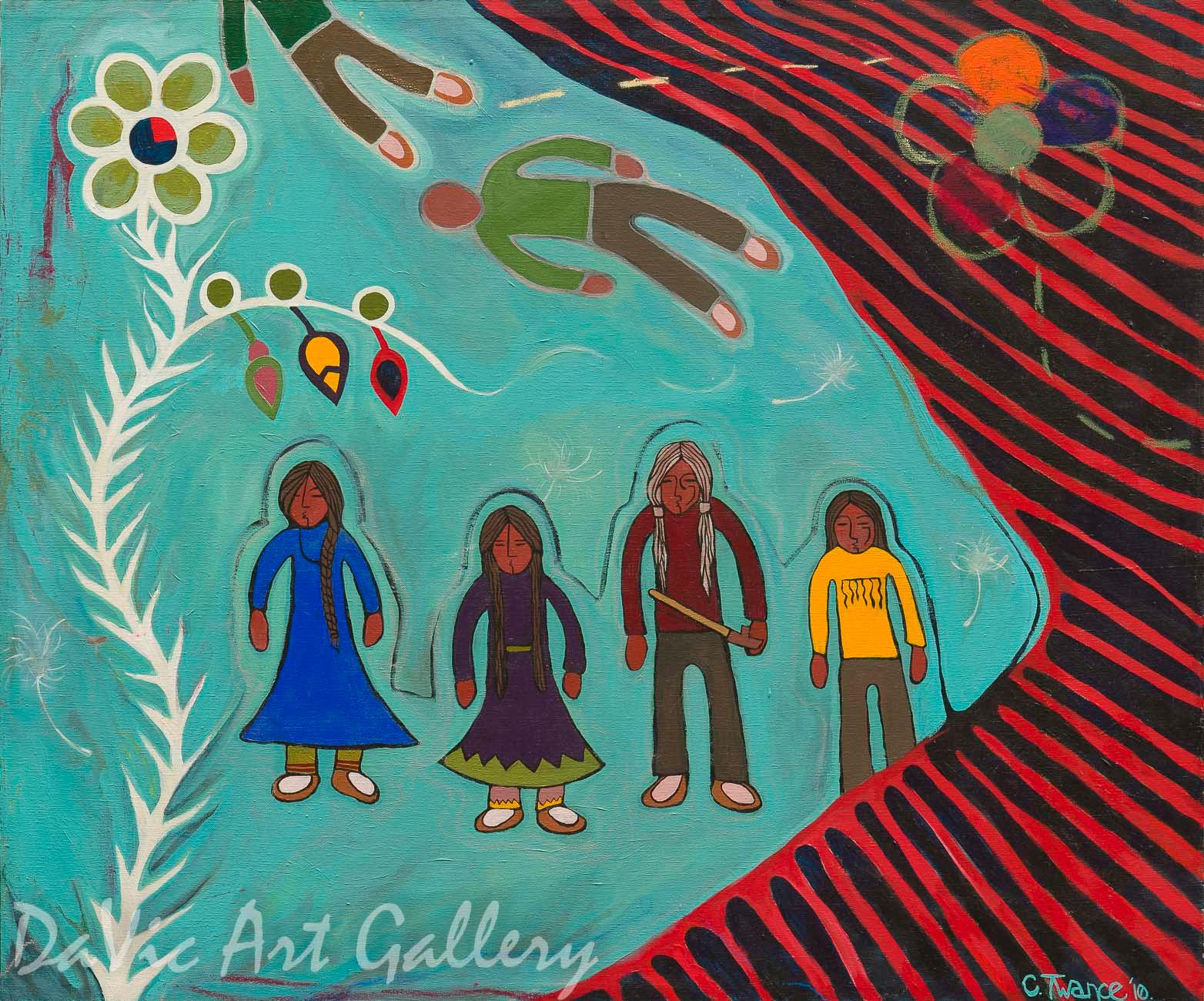artwork by candace twance featured on the davic art gallery
also known as orange shirt day, september 30th is marked to honour and remember children and communities that suffered through residential schools. as well as many, who did not survive.
phyllis webstad from the stswecem’c / Xgat’tem first nation is a residential school surviour. she tells her story of her orange shirt. the beginning of school season was an emotional time for many indigenous families and communities, as kids are getting taken away. "her granny had managed to save enough money to buy her a new outfit for school. phyllis remembers her shiny orange shirt, with a string lacing it up the front, and her shiny 6-yr old self who felt so excited to be going off to school." though, once phyllis arrived to the mission, her orange shirt was stripped from her. "the color orange has always reminded me of that and how my feelings didn’t matter, how no one cared and how i felt like i was worth nothing."
for the past 7 years, the canadian committee for truth and reconciliation have advocated for 94 calls to action to give government a road map to reconcile their tragic history. as of 2022, there has been 11 completed. from the podcast titled unreserved in the episode called "making the most of the national day for truth and reconciliation", eva jewell who is the research director at the yellowhead institute, mentions how there are many issues that are still being repeated. some of which are discrepancies in health care for indigenous communities, as well as incarceration rates. she gives canada the grade level "d" for the efforts put in thus far - not a grade you'd like to see on your report card.
this day is about honouring indigenous history, reflecting on canada's mistakes, and listening to indigenous voices. as i am not an indigenous person, nor are we an indigenous business, today i will be sharing stories and recollection from indigenous people about canada's true history.
john jones, member of the nanoose first nation and survivor of the alberni residential school
the alberni residential school was located on the west bank of the somass river on vancouver island. it was south of the tseshaht reserve tsahaheh 1 and about 4 kilometres north of port alberni. there was a girls school and a boys school, but in 1899, the school's population had grown far past it's capacity. they instructed the boys of the school to build a new, larger building. young boys were doing roofing, structural building, and more rigorous manual labour. religious teachings were made a #1 priority; boys under 10 were forced to remember and recite hundreds of lines of scripture.

many former students of alberni residential school have testified to the physical and sexual abuse that occurred there. one of those former students, now father, grandfather, and great-grandfather, john jones. jones was 7 years old when he was sent to alberni residential school. he remembers being a normal kid before then, he enjoyed playing and he was loved. from the moment he arrived, he remembers seeing children just like him be abused for speaking their traditional language: "one of the things that we had to do was watch the supervisor strap our friends with a strap that was made out of a fire hose...to this day, I can't speak our traditional language, and I think it's because of watching my friends getting strapped for speaking their language."
here is a story john told for an interview with wbur newspaper:
"boys sometimes peed their bed, and the counselor would make us form two lines facing each other with our belt in our hands. And as each of the person that was being punished for peeing the bed [passed], we would have to whip them with our belt as they passed to the lines. I chose not to with my friends, and as a result, I had to go through that line and get whipped myself. and each time their punishment took place, I chose not to whip them, but to get punished with them.
i'd seen one of my friends with a chocolate bar, and I asked him where he got it. and he said he got it from a male supervisor called mr. plint. you know, so I went and asked him if I could have a chocolate bar. and he said he hasn't got one, but if I go back while everybody's asleep, he'd give me one. so I waited for everybody to fall asleep. and I went to him, went to his office. and he showed me into his bedroom that was attached to the office. that's where the sexual abuse stopped."
lucille mattess from the ti,azten nation, survivor of the lejac indian residential school
lucille attended residential school for 8 years. she was there from the time she was about 5 or 6 years old until around 14 years old. she doesn't remember going there or being taken - she just remembers waking up in a room with other children. lucille remembers the hard work they were forced to do, cleaning toilets, scrubbing floors;"it was just all structured. i never ever remember making any decisions of my own. it was kind of like we were programmed."
they were able to go home for holidays and a few weeks in the summertime, but they lived with the trauma and suffering even outside of the school. "christmas time wasn’t a very good experience because there was so much dysfunction, so much alcohol happening in the community." lucille remembers her time spent at home, she didn't have fear, she felt free. but back at residential school, they were instilled with fear. "it was after those fears that I came to fear a lot of things at home. i came to fear what was going on around me. they made you feel you were not good enough, not acceptable to god, especially when as a child you saw the nuns strapping the little ones that came in after me, they were being strapped because they were talking in their language, the carrier language, they were talking their language and they were strapping them because they were telling these kids that this was a devilish babbling."
when lucille was out of residential school, she immediately began to suffer effects from her experiences growing up in that environment. "in 1984 that’s when i became aware that my symptoms were from residential school. i suffered from anxiety attacks. i suffered from fears. i suffered i abused prescription drugs and alcohol. prescription drugs was my number one. sleeping pills and valiums in the day time and sleeping pills at night. I used that for 2 years prior to 1984 because prior to that I was using alcohol right from age twelve, which was my first experience with alcohol."
lucille tried to escape lejec about 4 times. one time, she was caught and got her hair cut off. her only remark about that instance was "we already felt ugly anyways."
"we were basically never nurtured. we were emotionally deprived by invalidating our emotions. and if you did cry nobody acknowledged it. nobody came over to ask, “what is wrong, lucy?” you just had to lay in your bed at night and just cry."
after leaving the residential school, lucille felt as thought there was no place for her in the 'real world'. "I was ashamed to be an Indian. I was very ashamed to be an Indian. I didn’t want to acknowledge being an Indian."
"today i think service providers and professional people and non-aboriginal people need to know the history of the aboriginal people and what happened to them. governments need to know those things because as a service provider myself I am working with the debris of the government policies, the psycho-social problems of our people. that’s the suffering we see today. they need to know."
lucille's story, and many others', are recorded and written here. take the time to listen, understand, and sympathize with members of indigenous communities.
to further your reading and knowledge from indigenous people, here are a list of books about canada's true history. click here for book list
here are a few other resources to look at:
https://thechildrenremembered.ca/
https://nctr.ca/
https://www.indianhorse.ca/


Leave a comment